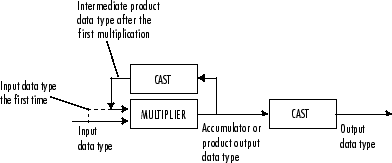Matrix Product
行、列、または入力全体に沿った行列要素の乗算

ライブラリ:
DSP System Toolbox /
Math Functions /
Matrices and Linear Algebra /
Matrix Operations
説明
Matrix Product ブロックは、M 行 N 列の入力行列の要素を、行に沿って、列に沿って、または全要素にわたって乗算します。
端子
入力
入力を M 行 N 列のベクトルまたは行列として指定します。
データ型: single | double | int8 | int16 | int32 | uint8 | uint16 | uint32 | fixed point
複素数のサポート: あり
出力
Matrix Product ブロックの出力。ベクトルまたは行列として返されます。ブロックが出力を計算する方法の詳細については、[乗算範囲] パラメーターの説明を参照してください。
データ型: single | double | int8 | int16 | int32 | uint8 | uint16 | uint32 | fixed point
複素数のサポート: あり
パラメーター
[メイン] タブ
乗算する対象の次元を次のいずれかとして指定します。
列–– ブロックは各列の要素を乗算し、結果の 1 行 N 列の行列を出力します。ブロックは、長さが M の方向性をもたないベクトル入力を M 行 1 列の行列として扱います。行–– ブロックは各行の要素を乗算し、結果の M 行 1 列の行列を出力します。ブロックは、長さ N の方向性をもたないベクトル入力を 1 行 N 列の行列として扱います。入力全体–– ブロックは入力のすべての要素を乗算し、結果のスカラーを出力します。
[データ型] タブ
メモ
浮動小数点の継承は、このペインで定義されるデータ型の設定よりも優先されます。入力が浮動小数点の場合、ブロックはこれらの設定を無視し、すべての内部データ型は浮動小数点になります。
このパラメーターをオンにすると、ブロックは固定小数点演算の結果を飽和させます。このパラメーターをオフにすると、ブロックは固定小数点演算の結果をラップします。saturate および wrap の詳細については、固定小数点演算のオーバーフロー モードを参照してください。
中間の乗算器のデータ型を指定します。固定小数点データ型に示すように、ブロックは、入力の次の要素を乗算する前に、乗算器の出力を中間の乗算器のデータ型にキャストします。このパラメーターは以下のように設定できます。
データ型継承ルール。例:
[継承: 入力と同じ]有効なデータ型として評価する式。例:
[fixdt([],16,0)]
[データ型アシスタントを表示] ボタン  をクリックして、[乗算出力] パラメーターの設定を行うための [データ型アシスタント] を表示します。
をクリックして、[乗算出力] パラメーターの設定を行うための [データ型アシスタント] を表示します。
詳細については、データ型アシスタントを利用したデータ型の指定 (Simulink)を参照してください。
乗算出力のデータ型を指定します。このブロックの乗算出力データ型の使い方を示す図については、固定小数点データ型および乗算のデータ型を参照してください。このパラメーターは以下のように設定できます。
データ型継承ルール。例:
[継承: 内部ルールによる継承]。このルールの詳細については、内部ルールによる継承を参照してください。データ型継承ルール。例:
[継承: 入力と同じ]。有効なデータ型として評価する式。例:
[fixdt([],16,0)]
[データ型アシスタントを表示] ボタン  をクリックして、[乗算出力] パラメーターの設定を行うための [データ型アシスタント] を表示します。
をクリックして、[乗算出力] パラメーターの設定を行うための [データ型アシスタント] を表示します。
詳細については、データ型アシスタントを利用したデータ型の指定 (Simulink)を参照してください。
アキュムレータのデータ型を指定します。このブロックのアキュムレータ データ型の使い方を示す図については、固定小数点データ型を参照してください。このパラメーターは以下のように設定できます。
データ型継承ルール。例:
[継承: 内部ルールによる継承]。このルールの詳細については、内部ルールによる継承を参照してください。データ型継承ルール。例:
[継承: 入力と同じ]。データ型継承ルール。例:
[継承: 乗算出力と同じ]。有効なデータ型として評価する式。例:
[fixdt([],16,0)]
[データ型アシスタントを表示] ボタン  をクリックして、[アキュムレータ] パラメーターの設定を行うための [データ型アシスタント] を表示します。
をクリックして、[アキュムレータ] パラメーターの設定を行うための [データ型アシスタント] を表示します。
詳細については、データ型アシスタントを利用したデータ型の指定 (Simulink)を参照してください。
出力データ型を指定します。このブロックの出力データ型の使い方を示す図については、固定小数点データ型を参照してください。このパラメーターは以下のように設定できます。
データ型継承ルール。例:
[継承: 乗算出力と同じデータ型継承ルール。例:
[継承: 入力と同じ]。有効なデータ型として評価する式。例:
[fixdt([],16,0)]
[データ型アシスタントを表示] ボタン  をクリックして、[出力] パラメーターの設定を行うための [データ型アシスタント] を表示します。
をクリックして、[出力] パラメーターの設定を行うための [データ型アシスタント] を表示します。
詳細については、信号のデータ型の制御 (Simulink)を参照してください。
ブロックが出力する最小値を指定します。既定値は [] (指定なし) です。Simulink® は、以下を行う際にこの値を使用します。
シミュレーション範囲のチェック (信号範囲の指定 (Simulink)を参照)
固定小数点データ型の自動スケーリング
ブロックが出力する最大値を指定します。既定値は [] (指定なし) です。Simulink は、以下を行う際にこの値を使用します。
シミュレーション範囲のチェック (信号範囲の指定 (Simulink)を参照)
固定小数点データ型の自動スケーリング
ブロック ダイアログ ボックスで指定するデータ型が固定小数点ツールによってオーバーライドされないようにするには、このパラメーターを選択します。
ブロックの特性
データ型 |
|
直達 |
|
多次元信号 |
|
可変サイズの信号 |
|
ゼロクロッシング検出 |
|
詳細
拡張機能
生成されたコードは特定の条件下で関数 memcpy または関数 memset (string.h) に依存します。
固定小数点の変換
Fixed-Point Designer™ を使用して固定小数点システムの設計とシミュレーションを行います。
バージョン履歴
R2006a より前に導入
MATLAB Command
You clicked a link that corresponds to this MATLAB command:
Run the command by entering it in the MATLAB Command Window. Web browsers do not support MATLAB commands.
Web サイトの選択
Web サイトを選択すると、翻訳されたコンテンツにアクセスし、地域のイベントやサービスを確認できます。現在の位置情報に基づき、次のサイトの選択を推奨します:
また、以下のリストから Web サイトを選択することもできます。
最適なサイトパフォーマンスの取得方法
中国のサイト (中国語または英語) を選択することで、最適なサイトパフォーマンスが得られます。その他の国の MathWorks のサイトは、お客様の地域からのアクセスが最適化されていません。
南北アメリカ
- América Latina (Español)
- Canada (English)
- United States (English)
ヨーロッパ
- Belgium (English)
- Denmark (English)
- Deutschland (Deutsch)
- España (Español)
- Finland (English)
- France (Français)
- Ireland (English)
- Italia (Italiano)
- Luxembourg (English)
- Netherlands (English)
- Norway (English)
- Österreich (Deutsch)
- Portugal (English)
- Sweden (English)
- Switzerland
- United Kingdom (English)
